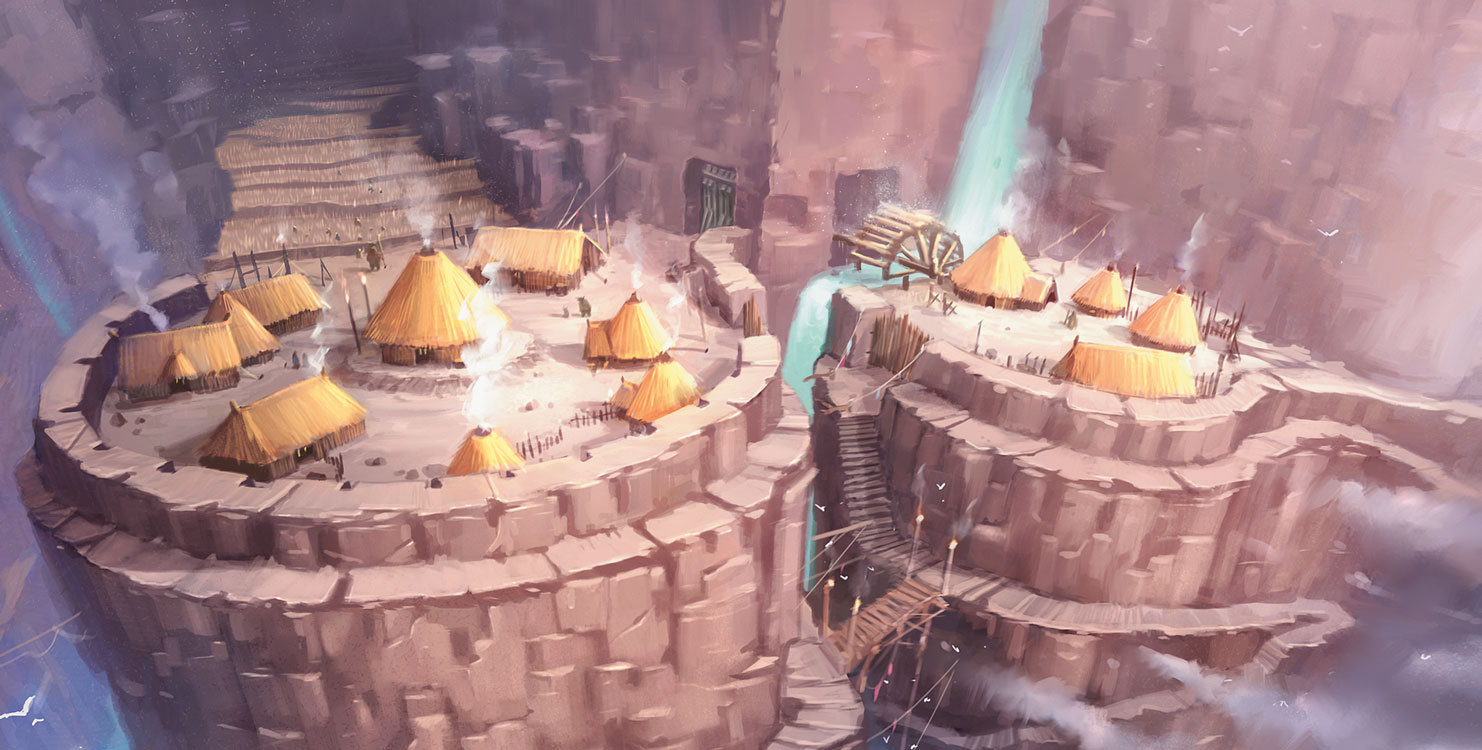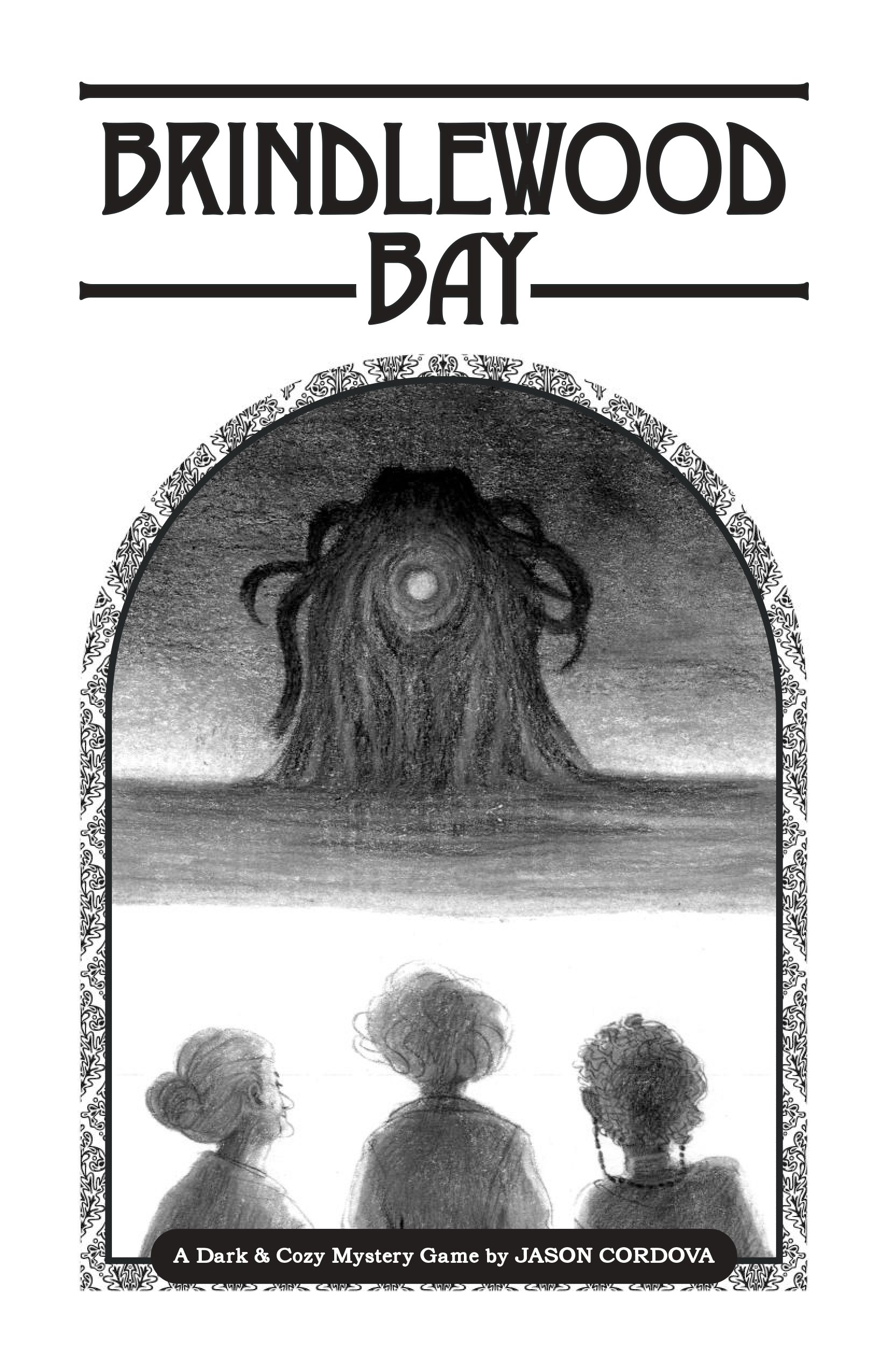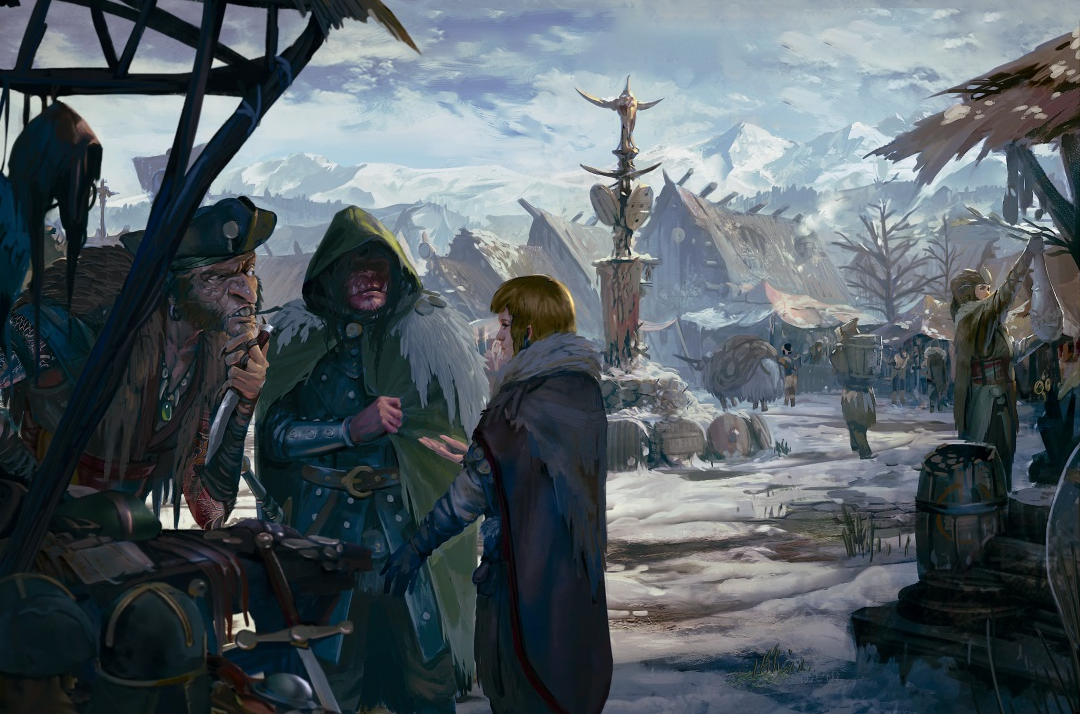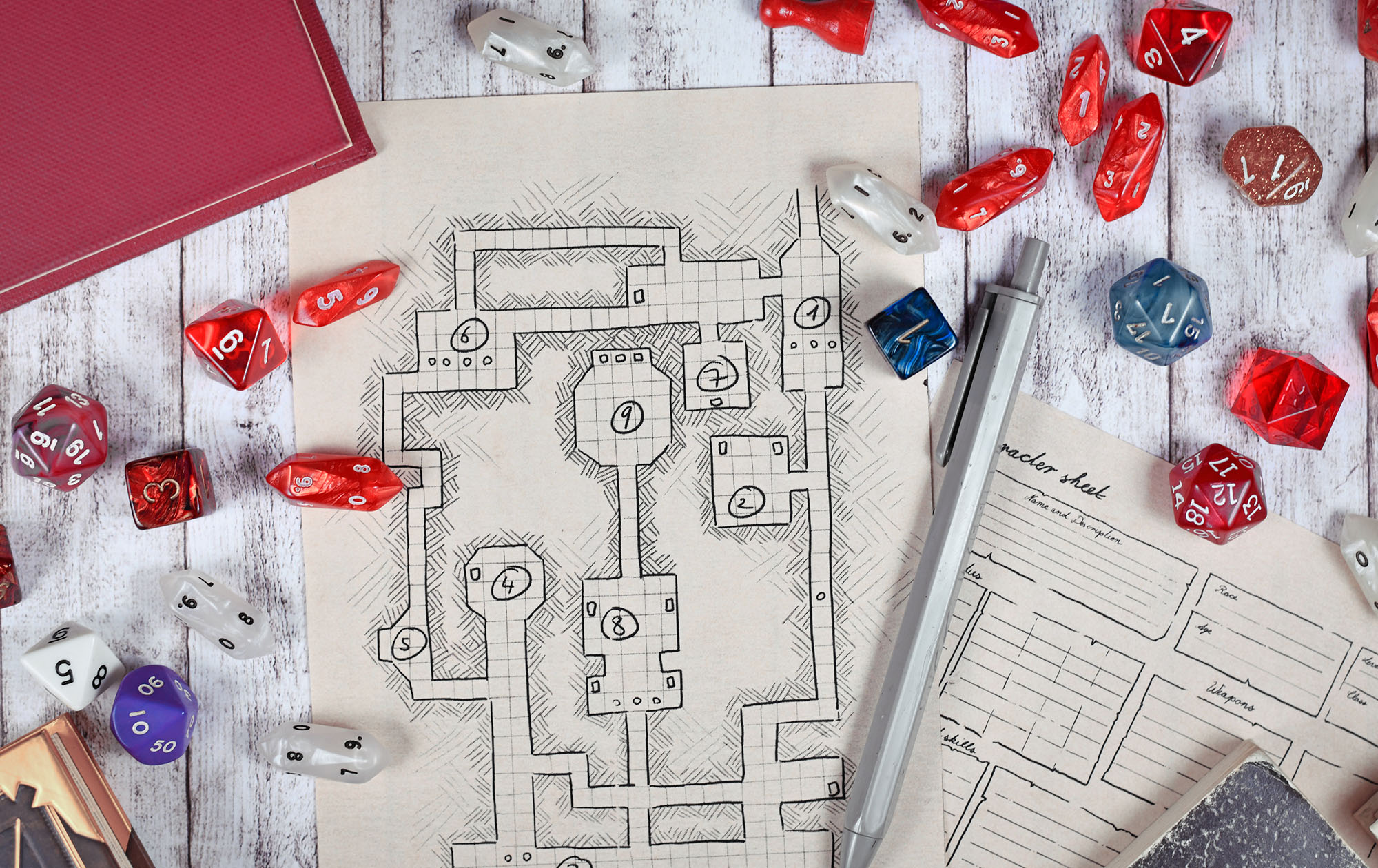We took a look at the Questioning/Backtracking Giants leads in this section of the campaign earlier. To that end, I’ve collapsed these leads into a single entry for each revelation (with an accompanying list of instances). There are such leads pointing to all five of the non-Maelstrom lairs.
To this we can also add the Eye of the All-Father, which similarly points to all of these lairs.
Structurally, I decided that each lair should also have a lead pointing to it from one of the other giant lairs. This means that once the PCs “punch up” into this layer of the campaign, it will be possible for them to circulate between the giant lairs. (These leads also, by their nature, begin to reveal the factional rivalries and politics between the giants.)
This gives us three clues for each lair, but they’re both formulaic and also very internal to the giants (they’re either the giants themselves, their lairs, or their oracle). So I finished fleshing out these revelation lists by adding one “outside” option to each list. (These are also the clues that the PCs will encounter while moving through the pointcrawl-like structure of Phase 3.)
Maelstrom is an exception to all this: It gets one clue pointing to it from each giant lair plus the prebuilt route through the Eye of the All-Father.
If you wanted to add an extra option to these revelation lists, you might consider putting a map of all known giant lairs somewhere in the Maelstrom. This makes sense (the Storm Giants were ruling over all of these places until just recently and/or Serissa would be doing her best to keep tabs on everyone) and creates the opportunity for a structure where the PCs punch up through the giant lairs, reach Maelstrom, and can then see the whole strategic picture of the giant situation. (Either as a result of the map or by forming an alliance with Serissa.)
I usually try to avoid this kind of “all the clues in one basket” approach because it can obviously short circuit the entire investigation. (All the answers the PCs want, after all, are conveniently right here for them.) Given the overall structure here, though, it’s probably fine. And you could also temper things by making the current locations of, say, Lyn Armaal and Kayalithica a mystery to Serissa.
GRUDD HAUG – DEN OF THE HILL GIANTS
- Frost-Touched Monolith (Triboar). In the courtyard of the Frost-Touched Frog, there is a stone sarsen that stands about nine feet high. Written in Dethek characters in a Giant (Jotun) language is the message, “Here are the lands of the Hill Giants. Decreed as Law by the Eye of the All-Father. Let no small folk enter here, or they shall find our stomachs are their final destination.” The stone was once one that marked the territory around Grudd Haug, but was removed a generation ago by treasure-seekers and brought to Triboar, where Alatha Riversword, the former proprietress of the Frost-Touched Frog, accepted it as payment for a bar debt on a lark. (Either documents can be found in the abandoned tavern testifying to where the monolith was originally found. Or they may need to track down the tavern’s current owner, Artus Riversword (see the Helm’s Hold lead to Triboar, described above).
- High Forest Poachers. PCs who are crossing the High Forest may stumble across the slaughtered remains of megafauna (huge deer, etc.) who have been slain by hill giants and then taken back to Grudd Haug. (It’s possible that the PCs might encounter hunters from Noanar’s Hold, p. 101, inspecting the kill site.)
- Deadstone Cleft – Area 14: Temple. Kayalithica has reports from scouts she sent to observe Grudd Haug. In addition to providing details of its location and a rough map of its exterior, the scouts also disdainfully report on Chief Guh’s disgusting effort to become “the largest giant” by literally eating her way to the distinction. They dismiss her rovers as being a threat to the stone giants; if anything, Guh has greatly weakened her strategic position by sending giant raiders to scour the surrounding countryside.
- Lyn Armaal – Area 14: Castellan’s Quarters. Cressaro has spy reports and maps identifying the location of Grudd Haug. These include an aerial map of the lodge. The reports of his spies describe with disdsain Chief Guh’s plan to eat her way to supremacy; they do express some concern that if her raiders get closer to the Evermoors they could rile up the people of Yartar or the elves of the High Forest and necessitate Lyn Armaal moving to a new location.
- Questioning/Backtracking Giants. Random Encounter (p. 70 & 71), Goldenfields (p. 51), Uluvin (p. 112), Old Tower (p. 116-7).
- Eye of the All-Father, p. 151. Oracle gives them directions.
DEADSTONE CLEFT – CANYON OF THE STONE GIANTS
- Uthgardt Blessings (Stone Stand). Members of the Blue Bear tribe, which has recently formed an alliance with Kayalithica of Deadstone Cleft, seek blessings from the Grandfather Oak at Stone Stand for their efforts. They do so by describing their endeavor on the tanned hide of a bear, which is then tied with blue gut-string in ceremonial knots and left within the clefts between the old oak’s roots. One of these was left by Kriga Moonmusk (p. 66) seeking blessing for her alliance with Kayalithica. The document includes a reference to Deadstone Cleft as Kayalithica’s fortress. (The PCs should be able to make inquiries to identify the location of Deadstone Cleft.)
- Silixia (Grayvale), p. 88. This young brass dragon will point the PCs towards Deadstone Cleft.
- Grudd Haug – Area 13: Prisoner. Gryhawk, the Uthgardt prisoner here, is from the Blue Bear tribe (instead of the Elk tribe). He was a spy sent by Kayalithica, but was captured by the giants. If freed, he will thank the PCs (as described on p. 144) and tell them that he is certain they will also have the thanks of the greater giants that he serves when he returns to Deadstone Cleft.
- Svardborg – Area 1G: Throne Room. Jarl Storvald has correspondence from Kayalithica, in which she proposes an alliance between them — one in which her giants will “tear apart all that the little ones have built, restoring Ostoria to its glory” under her rule, while Storvald’s reavers will “rule the seas.” Her letter notes that she has traveled to consult the oracles of Deadstone Cleft in the Graypeak Mountains, and it has suggested that the All-Father and fortune alike would smile on such an alliance.
- Questioning/Backtracking Giants. Grayvale Run (p. 88), Llorkh (p. 96), Orlbar (Zorkh, p. 103). The origins of the giants in Grayvale Run and Llorkh are not indicated in the text, but are from Deadstone Cleft.
- Eye of the All-Father, p. 151. Oracle gives them directions.
SVARDBORG – BERG OF THE FROST GIANTS
- Cloud Giant Cartographers. Count Nimbolo and Countess Mulara, the cloud giant cartographers who visit Waterdeep while the PCs are there (p. 113), were planning an expedition to Svardborg after investigating the giant settlement they believe Waterdeep was built atop of. Their maps include the approximate location of Svardborg in the Sea of Moving Ice, and notations indicate that it has been “recently reoccupied by frost giants.” If groups approach them in a more friendly way, they may mention this in conversation; they will certainly be eager to show off their new maps (allowing characters to notice the notation).
- Deadstone Cleft – Area 14: Temple. Kayalithica has correspondence from Jarl Storvald, apparently replying to some earlier letter Kayalithica sent to him proposing an alliance. The jarl is tentatively interested in “a world where you rule all the lands of lost Ostoria and my people rule all the oceans from the Sea of Moving Ice” as joint rulers of a new era, but stops short of actually promising anything. (Add Will the giants of Svardborg ally with us? to Kayalithica’s Questions, p. 153.)
- Questioning/Backtracking Giants. Bryn Shander (p. 41-2), Fireshear (p. 83), Helm’s Hold (p. 90), Luskan (p. 97), Port Llast (p. 104). Backtracking frost giants will generally lead you to their reaver ships. I recommend having navigational charts on the ships indicating the location of Svardborg.
- Eye of the All-Father, p. 151. Oracle gives them directions.
IRONSLAG – FORGE OF THE FIRE GIANTS
- King’s Request (Citadel Adbar), p. 78. King Harnoth asks the PCs to raid Ironslag.
- King and Queen’s Request (Citadel Felbarr), p. 79. King Morinn and Queen Tithmel ask the PCs to raid Ironslag.
- Lyn Armaal – Area 14: Castellan’s Quarters. Cressaro has spy reports and maps identifying the location of Ironslag. These include an aerial map of the Yakfolk Village (p. 174).
- Questioning/Backtracking Giants. Triboar (p. 60), Nesme (p. 100).
- Questioning Drow Raiders (Gauntlgrym), p. 85-86. Drow thieves from Ironslag can be caught in Gauntlgrym.
- Eye of the All-Father, p. 151. Oracle gives them directions
Note: If the PCs are wandering around the Silver Marches trying to figure out where the fire giants are, don’t hesitate to have NPCs suggest they might go to Citadel Adbar or Citadel Felbarr for aid. (This could equally well apply to any other goals the PCs might be pursuing in the region. Or if they’re working with a faction, the faction might send them to the dwarven kings and queens to discuss a potential alliance against the giants.)
LYN ARMAAL – CASTLE OF THE CLOUD GIANTS
- Zymorven Hall. From their outlook over the Evermoors, the knights of Zymorven Hall (p. 62) have observed winged figures repeatedly flying out of the Evermoors and heading towards the northwest. Lord Harthos Zymorven is concerned that the village of Rivermoot (p. 106), which lies in that direction, may be at risk from these creatures and asks the PCs to investigate. (The winged figures are aarokocra from Lyn Armaal, who are purchasing supplies and food in Rivermoot.)
- Random Encounter, p. 69. The PCs see Lyn Armaal flying above them.
- Ironslag – Area 26: Ducal Quarters. Zalto has correspondence from Countess Sansuri, the Lady of Masks, suggesting/asserting that, with the Ordning broken and the dominion of the Storm Giants at an end, Zalto should swear fealty to her and they could rise together to the top of the new Ordning. (The suggestion has enraged Zalto.) There are also reports from Zalto’s spies, who report that Lyn Armaal seems to have taken up a semi-permanent station above the Evermoors while the cloud giants are searching for something. (Or possibly multiple things.)
- Questioning Cartographers. Count Nimbolo and Countess Mulara, the cloud giant cartographers who visit Waterdeep while the PCs are there (p. 113), have heard that Countess Sansuri is interested in obtaining more up-to-date maps of the lands controlled by the little people. Nimbolo and Mulara aren’t really interested in that, but Sansuri’s agents have requested that they visit Lyn Armaal above the Evermoors. (The agent did suggest that the Lady of Masks was searching for some sort of ancient giant artifact… which does intrigue the cartographers somewhat.)
- Eye of the All-Father, p. 151. Oracle gives them directions.
MAELSTROM – HOLD OF THE STORM GIANTS
- Eye of the All-Father, p. 151. Oracle tells them that they need a conch of teleportation.
- Grudd Haug – Area 2: Feasting Hall. Chief Guh believes that once she’s placed atop the new Ordning that the All-Father will give the Maelstrom to the hill giants. (Why the hill giants would even want it is unclear; it really can’t be emphasized just how stupid Guh is.) She has scrawled a crude and mostly inaccurate map of Maelstrom on the wall next to her, indicating how she would redecorate.
- Deadstone Cleft – Area 14: Temple. Kayalithica is conspiring with Iymrith. (She does not know that Iymrith is a dragon.) Iymrith’s latest letter scolds Kayalithica, saying that she is “as impatient as the sisters. Serissa’s reign will end soon enough, but we must not move too quickly. Let her failures continue to mount and her support will continue to wither away. Then the legacy of Hekaton will be undone completely, and the storm lords will be lost in chaos while the fate of the new Ordning is decided.”
- Svardborg – Nilraun. The jarl has had Nilraun using experimental techniques to use the conch of teleportation to cast scrying and clairvoyance spells into Maelstrom. He has discovered that Iymrith is a blue dragon, but has not revealed that information to the jarl.
- Ironslag – Brimskarda. In her bodice, Brimskarda has a letter sent to her by Serissa. It appears that Serissa and Brimskarda were once drinking buddies when they were younger; apparently conspiring as friends during various diplomatic summits that their fathers attended. Serissa calls upon these old bonds, hoping that Brimskarda will intercede with Duke Zalto and convince him to honor the fire giants’ contracts for supplying the storm giants with weapons. “Use the conch,” she urges, “And come visit us at Maelstrom. It shall be like old times again.” Brimskarda has not shown the letter to Zalto.
- Lyn Armaal – Area 14: Castellan’s Quarters. Among Cressaro’s papers is a request from the Lady of Masks to a prepare a plan for using the conch of teleportation to infiltrate Maelstrom. (Cressaro has not yet had time to work on this.)
















